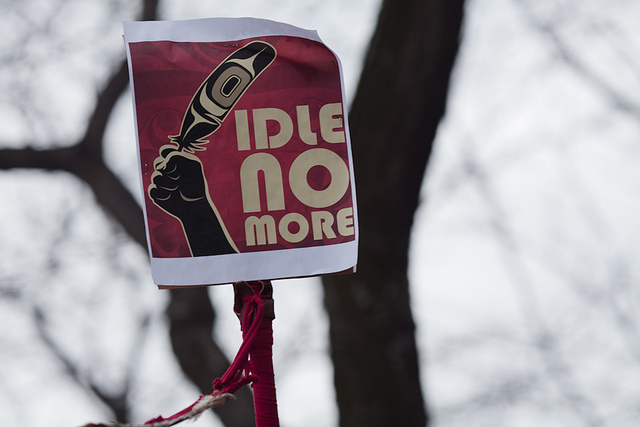
Theresa Spence is a 49-year-old woman with short brown hair, square green glasses, and the soft, clipped cadence of the Attawapiskat First Nation in northern Ontario, of which she is the chief. Over the past month, Spence has become a national figure in Canada, both admired and criticized for her stubbornness and conviction. Since December 12, she has been camped out on Victoria Island in Ottawa, not far from Parliament, subsisting only on water, fish broth, and tea.
Spence’s hunger strike is just one part of an unprecedented, widespread protest movement in Canada called Idle No More. It’s a major news story in my native country but hasn’t received much coverage on this side of the border. Originally started by indigenous women, Idle No More seeks to bring attention to the plight of Canada’s aboriginal population, known there as First Nations. The movement has swept across Canada in the form of demonstrations, marches, and flash mobs; inside Eaton Centre, downtown Toronto’s largest mall, an enormous crowd gathered to perform a round dance with singing and drumming. On January 16, blockades disrupted passenger train and highway traffic across the country. The movement has taken many Canadians by surprise, and it shows no sign of losing strength; another major day of protest is planned for next week, when Parliament returns from its winter break.
The catalyst for all these protests was a bill passed by Prime Minister Stephen Harper’s Conservative government, which, among other changes, eases environmental regulations, opening up lucrative natural resources. The bill was contested by many First Nations people, who feel it violates their treaty rights. But the grievances go beyond the passage of this particular legislation, throwing a spotlight on the extremity of problems among the First Nations. “We have a Third World in Canada, and it’s with our aboriginal peoples,” the Haitian-born former Governor General Michaëlle Jean recently told the CBC. The roots of these problems are both broad and historical, and they raise dark and difficult questions about what kind of country Canada is—and wants to be.
Every place has stories it likes to tell about itself. One pillar of Canada’s mythology has to do with its vast landscape, a source not just of beauty but wealth. Other countries might be political superpowers with global clout and a bigger GNP. Canada has its own kind of security, one derived from the ample resources of water, timber, and fisheries. Images of natural splendor are iconic to Canadians; our land is our treasure chest, and our shared bounty.
A second story about Canada is that it’s a cultural mosaic, not an American-style melting pot. Sprung from the dual colonialism of the English and French, officially bilingual, Canada understands and recognizes difference. The word sovereignty, referring to the right of a community within Canada to govern itself, is a standard element of the political discourse. When you’re a part of Canada, this story goes, you don’t give up your identity; you add it to a diverse community.
As with all myths, the reality behind both these stories is a great deal more complicated. Having grown up in Quebec, witnessing the constant seesaw of separatist politics, I’ve always been aware of that. But the intersection between environmental values and political sovereignty is most dramatic when it comes to the First Nations. The protest movement now cresting speaks of a profound anger with the way environmental stewardship is handled in Canada, and of a community that feels robbed of political and economic self-determination.
Like a lot of Canadians, I first started to think about these issues during the 1990 Oka Crisis, an armed standoff just outside Montreal that lasted almost three months, from July to September. The town of Oka wanted to develop a golf course on land that had historically been used by the Mohawk and included an ancestral burial ground. Over the course of the summer, there were barricades and major road blockages—for a time the Mercier Bridge, a major artery in and out of the island city, was closed—and one person died. In the end, a settlement was reached and the golf course was scratched. But a sense of unease lingered.
My childhood home was half an hour from Oka—and I went to high school with a few students from Kahnawake, also a Mohawk reserve—but up until the summer of 1990 my understanding of aboriginal politics was virtually nonexistent. I followed the news about Oka every day, troubled and astonished by the turn of events. Was this my home?
In the years since Oka, the conversation about aboriginal life in Canada has grown louder. People like me have learned about the history of residential schools, where children were separated from their families and forbidden to speak their own language (and some, most terribly, abused there). The systemic problems that the First Nations people face now—among them, poverty, addiction, inadequate housing, difficulties getting access to education, and healthcare—are inseparable from the historical actions that splintered communities and changed their relationship to the land on which they live.
Some Canadians have reacted negatively to the demands made by Idle No More. As with the Occupy movement, there is no single spokesperson or hierarchy, leading to charges of disorganization. Much attention has been paid to the fact that Spence’s partner was accused of financial mismanagement in their reserve. But earlier this week, the satirical hashtag “Ottawaspiskat” blew up on Twitter, as people pointed out that many of the same allegations—of divided leadership, of financial impropriety—could be made of the Canadian government itself.
It’s unclear how much longer Spence’s strike will go on; she has said she’s willing to die for her people. Meanwhile, other leaders of the movement call for different tactics: peaceful demonstrations, and more education. As the protests continue, Canadians will try to figure out what kind of country they live in; what kind of story they’ll learn, in the future, to tell about the past.




Send A Letter To the Editors